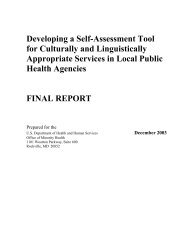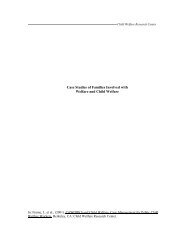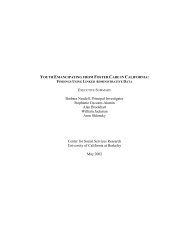Family Assessment in Child Welfare - Center for Social Services ...
Family Assessment in Child Welfare - Center for Social Services ...
Family Assessment in Child Welfare - Center for Social Services ...
You also want an ePaper? Increase the reach of your titles
YUMPU automatically turns print PDFs into web optimized ePapers that Google loves.
The NCFAS <strong>for</strong> Reunification (NCFAS-R), a collaborative ef<strong>for</strong>t between the National<strong>Family</strong> Preservation Network and the University of North Carol<strong>in</strong>a at Chapel Hill, is anassessment <strong>in</strong>strument used to assist caseworkers us<strong>in</strong>g <strong>in</strong>tensive family preservation servicestrategies to successfully reunify families where children have been removed from the home dueto substantiated abuse and or neglect, juvenile del<strong>in</strong>quency, or the receipt of mental healthservices <strong>in</strong> a “closed” treatment sett<strong>in</strong>g (Reed-Ashcraft et al., 2001). The scale provides familyfunction<strong>in</strong>g assessment rat<strong>in</strong>gs on seven doma<strong>in</strong>s relevant to reunification: (1) environment, (2)parental capabilities, (3) family <strong>in</strong>teractions, (4) family safety, (5) child well-be<strong>in</strong>g, (6)caregiver/child ambivalence, and (7) read<strong>in</strong>ess <strong>for</strong> reunification. Like the NCFAS, change scores<strong>for</strong> the NCFAS-R illustrate the amount of measurable change that is achieved dur<strong>in</strong>g the serviceperiod from <strong>in</strong>take rat<strong>in</strong>gs through closure rat<strong>in</strong>gs. Internal consistency and concurrent validity <strong>in</strong>relation to the success or failure of reunification cases have been established <strong>for</strong> this measure.The Strengths and Stressors Track<strong>in</strong>g Device (SSTD) is another modification of theNCFAS that assesses the strengths and needs of families at <strong>in</strong>take to help guide case plann<strong>in</strong>gand evaluate the effectiveness of treatment. The SSTD is shorter than the NCFAS <strong>in</strong> its two-page<strong>for</strong>m but <strong>in</strong>cludes an additional 16 items (<strong>for</strong> a total of 55 items). The SSTD can be completed bycaseworkers <strong>in</strong> less than 30 m<strong>in</strong>utes. Like the NCFAS, family strengths and stressors are rated ona Likert type scale, with -2 <strong>in</strong>dicat<strong>in</strong>g a serious stressor to +2 <strong>in</strong>dicat<strong>in</strong>g a clear strength. Unlikethe NCFAS, psychometric <strong>in</strong><strong>for</strong>mation <strong>for</strong> the SSTD is somewhat limited. In a small validationstudy <strong>in</strong> a s<strong>in</strong>gle agency, the SSTD demonstrated high <strong>in</strong>ternal consistency <strong>in</strong> all doma<strong>in</strong>s,dist<strong>in</strong>guished between physical abuse and neglect cases at <strong>in</strong>take, and appeared to be sensitive tospecific changes made by families dur<strong>in</strong>g the treatment period (Berry, Cash, & Mathiesen,2003). However, further use and validation are needed to establish content and criterion relatedvalidity, <strong>in</strong>clud<strong>in</strong>g predictive validity, as well as test-retest reliability.<strong>Family</strong> <strong>Assessment</strong> Form (FAF). The FAF is a practice-based <strong>in</strong>strument that wasdeveloped by the <strong>Child</strong>ren’s Bureau of Los Angeles, a nonprofit child welfare agency, to helppractitioners improve the assessment of families receiv<strong>in</strong>g home-based services. The FAF iscurrently used <strong>in</strong> practice, tra<strong>in</strong><strong>in</strong>g, and research sett<strong>in</strong>gs. The <strong>in</strong>strument <strong>in</strong>cludes 39 items thatrelate to the follow<strong>in</strong>g five factors: (1) liv<strong>in</strong>g conditions, (2) f<strong>in</strong>ancial conditions, (3) <strong>in</strong>teractionsbetween adult caregivers and between caregivers and children, (4) support available to11
















